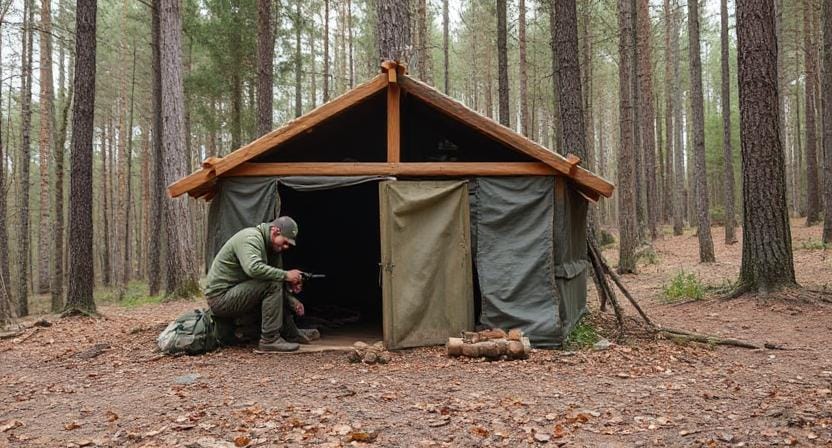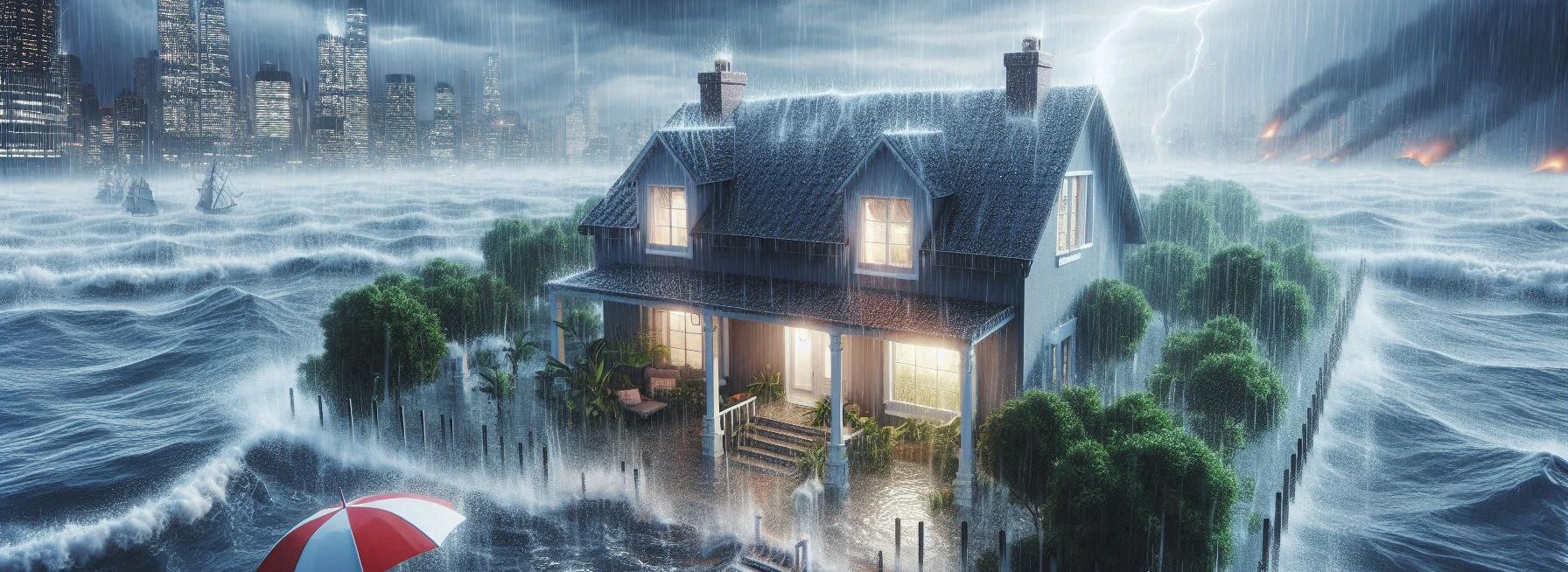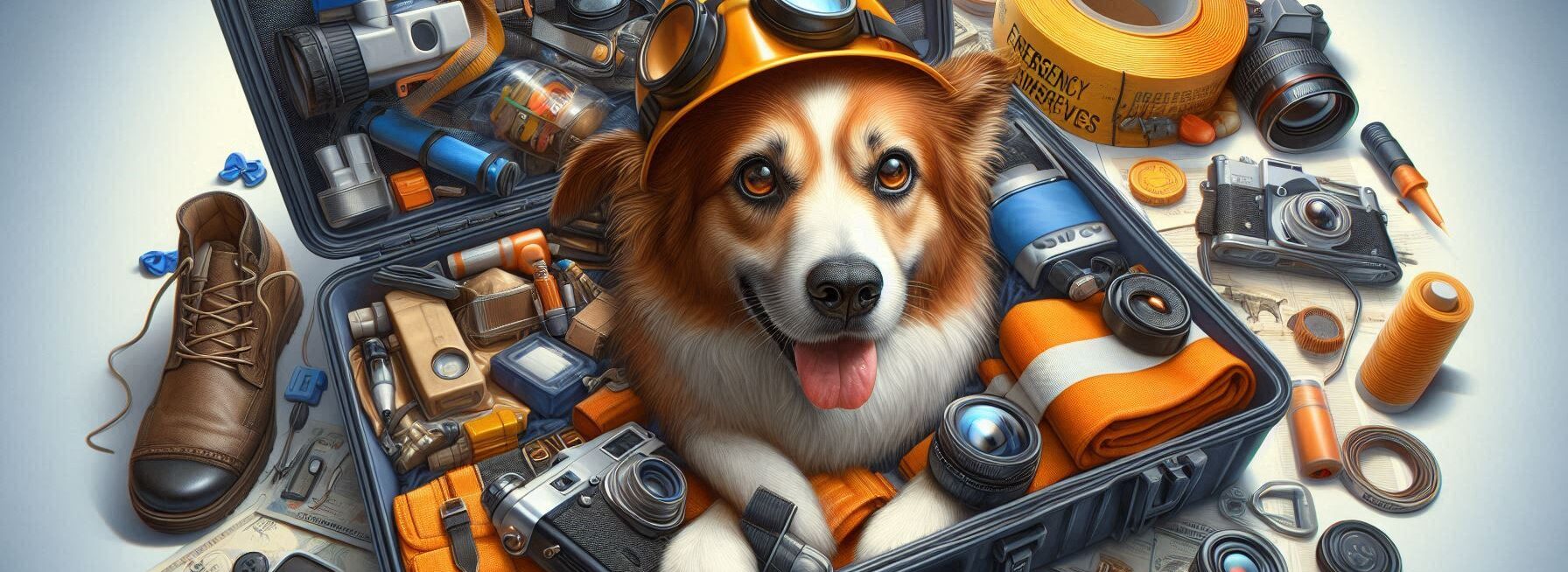Please Note: This post may contain affiliate links. If you click one of them, we may receive a commission at no extra cost to you. As an Amazon Associate, I earn from qualifying purchases.
Last Updated on November 1, 2025 by Kevin Collier
Top Takeaways and Key Concepts
– Choose high, dry ground; avoid valleys, lone trees, avalanche paths.
– Face entrance leeward; use natural windbreaks; anchor shelter securely.
– Match shelter to climate: tarp A-frame, debris hut, snow cave.
– Insulate ground thickly; use leaves, pine boughs, foam pad.
– Ventilate near apex; keep fire outside; maintain clear emergency exit.

When something bad happens, it can be really scary. It seems like natural disasters, like storms or floods, come out of nowhere. Or maybe you've been on a fun trip that turned into a crazy adventure that went bad. Having a sound plan for emergency shelters can help a lot, no matter what. Picture being outside in a storm with rain falling all around you and nowhere to go. Oh no! That's when you realize how much you need a safe, warm place to hide.
Let's discuss about shelters for emergencies. There are numerous kinds and techniques to produce them. Some people sleep in tents. Tents are fantastic because they're light and easy to carry. You can put them in your bag! Some people might use facilities like schools or community centers. They are protected and generally have food and water.
Also, think about the materials. What will you use if you decide to make your own? A strong tarp can do a lot of good. Just attach it to some trees or poles, and you're good to go! You have a quick somewhere to stay. Great! You have pillows and blankets. Inside will feel much cozier.
It might be a wonderful endeavor to build your own shelter. Get some sticks, leaves, and anything else you can find. Put a roof on top and cover the sides. Just be sure it is strong. You don't want it to break when it rains. Use what nature gives you; you might be surprised at how much you can find. And while you're building, don't forget to make it light so you can move fast if you need to. The name of the game is “easy to pack up.”
What if the weather is extremely bad? Think about the places you can go. Find sites that are high up but won't flood. You might stay dry if you are on the second floor of a building. And if you have to stay outside, look for big trees or rocks to protect you from the wind.
Planning ahead is also a smart idea. Talk to your friends or relatives. If something happened, where would you all go? Everyone knows where to find each other if they have a meeting place. When the characters in cartoons yell, “Meet back at the tree!” It's about making sure everyone is safe.
And don't forget to be calm. Breathing deeply helps. If you're terrified, focusing on your shelter can help. You can get through it if you have a strategy.
So, remember these guidelines. Knowing a little bit about emergency shelters could help you get through a challenging time. It's wonderful to be ready, even if you don't know when you'll need them. If the weather changes, think of where you could go the next time you're outside or on the road. It's all about being safe and comfortable, even when things get a little crazy.
Contents of This Page
*** Shop for Survival Gear - Tools - Kits ***
Survival Gear - Bags and Backpacks - Knives - Boots/Footwear - Communication
Outdoor Cooking - Gloves - Hydration - Dry Boxes - Water Filtration Systems
Tents - Sleeping Bags - First Aid Kits - Multi-Tools - Flashlights - Fire Starters
Navigation - Survival Food - Night Vision - Headlamps - Stun Guns - Binoculars
Understanding Emergency Shelters

What is an emergency shelter, first of all? You might think of it as your temporary castle against the weather. It is meant to keep you safe in case of unexpected events like hurricanes, snowstorms, or even zombie apocalypses (well, maybe not that last one—yet!). These shelters can be tents, lodges, or even makeshift buildings fashioned from anything you find lying around.
These shelters do more than just keep you dry, which is interesting. When the temperature drops suddenly, they are quite important for keeping your body heat. Think about it: while you're outside, even a little bit of cold can rapidly become a big problem, or worse, hypothermia. A well-built shelter protects you from the weather by keeping heat inside and producing a pleasant microclimate that feels like a warm hug on a cold day.
But we shouldn't forget about that important mental part! When the weather is bad outside, such strong winds, heavy rain, or the sound of thunder in the distance, having a safe place to go can really help your mental health. You know the sense of comfort and safety when you wrap yourself in a huge, warm blanket and drink hot cocoa? An emergency shelter gives you a safe place to stay when nature is unpredictable. You don't have to worry about getting wet or blown away by strong winds; instead, you may keep calm and plan your next move.
Also, shelters keep animals that might wish to join your excursion without being invited away. Think about how annoying it would be to attempt to relax and have raccoons throw a party outside your tent! A strong shelter keeps those annoying invaders away so you can relax without having to worry about them all the time.
And while we're talking about relaxing, imagine this: after a long day of hiking or walking across harsh terrain, there's nothing like cuddling up in your temporary home with some snacks (because snacks are life!). You might even think back to camping excursions you've taken in the past while watching the shadows dance around your campfire outside. In times like this, it's easy to see how important these shelters are—not just for staying alive, but also for making memories that will last a lifetime.
In the end, being able to build a safe base gives you the courage to take on any adventure that comes your way. Knowing that you have a place to stay offers you peace of mind, whether you're planning an escape route or just enjoying the beauty of nature from behind sturdy walls. Let's face it, everyone could use more cozy moments in the middle of life's unpredictability!
Types of Emergency Shelters

Now that we know the basics, let's look at some common forms of emergency shelters. A lot of people think of tents and cabins as the first possibilities that come to mind. Tents are easy to carry and light, making them great for camping trips or brief getaways into nature. Cabins, on the other hand, have stronger walls and roofs, but you might have to plan ahead more.
On the other hand, if you're feeling brave or maybe a little desperate, you may make your own shelters out of natural resources that are around you. Imagine this: walls made of fallen branches and leaves that keep you warm! Sounds like a good idea (and good for the environment), right? It's like being a nature architect and making your own snug retreat out of the things that are around you. Just think of how good it would feel to construct something useful with your own hands while also connecting with nature in a way that makes you feel like a true wilderness warrior.
Let's be honest for a second. Even while it sounds like fun, you should remember that Mother Nature doesn't always play kind. She can be unpredictable! That's why it's so useful to know how to make these rapid shelters. When the skies get dark and scary or the wind starts to howl like an angry wolf, knowing how to do some things can mean the difference between remaining dry and becoming one with the elements. Spoiler alert: no one wants that!
So where do you even begin? Look for resources first. Fallen branches are your best friends here because they are strong and can be used as structural supports. You may make a small log cabin without nails or any tools by leaning them against each other in a triangle configuration. Next, there are the gorgeous leaves and pine needles that are all over the place. They make great insulation! Putting them on top not only keeps the heat in, but it also helps keep the rain out.
It's interesting that time is really important while building these shelters. You want to work quickly but well because, let's be honest, no one likes to get wet while attempting to be like Bear Grylls! A lot of the time, working in groups can also help things go faster. If you have friends with you on this crazy adventure, split up the work: one person gathers branches and another person gathers leaves. You know what they say: “Teamwork makes the dream work.”
And don't forget to let air in! We enjoy our warm little forts, but it's important to keep the air moving so that they don't get stuffy or damp. You may leave small holes near the top or sides so that air can flow freely. This would be like giving your shelter its own room to breathe.
Take a minute to look at what you've made when you've completed crafting your masterpiece out of what nature has given you. Using your environment in innovative ways is quite satisfying. Also, it lets you brag about how you can survive in the woods without high-tech gear.
In conclusion, creating shelters with natural materials is a wonderful way to add an extra challenge to your outdoor pursuits, whether you need an emergency escape plan or just want to have some fun. So the next time you're surrounded by tall trees and rustling leaves, don't be afraid to tap into your inner builder. It could lead to a wonderful night beneath the stars!
Building Your Own Shelter

So, how do you really build one of these lifesavers? First things first: where you are is important! Find a high spot that isn't likely to flood or have trees fall on it. Safety first! After you've found the right place, collect things like branches, leaves, and rocks—anything that will help you build your tiny shelter.
To make a simple lean-to, lean a strong branch against a tree at an angle and then stack smaller sticks on top of it to make walls. To keep rain and wind out, cover everything with pine needles or leaves. It's honestly easier than putting together IKEA furniture without instructions!
And don't forget to open the windows! You want air to flow, but not too much, because no one wants to shiver uncontrollably while attempting to stay warm in their temporary shelter. Picture this: you've worked hard to build your cozy home, and just as you sit down and relax, a cold wind comes in like an uninvited guest. That nice layer of leaves suddenly feels like a wet towel, and you feel like all your work was for nothing. Not quite the mood you're hoping for!
So, how can you find the right balance? You should conceive of your shelter as a fragile ecology. To keep things from getting stuffy or wet, you need fresh air to flow through. This is especially important if you're cooking or breathing deeply after all that constructing! But if you allow in too much wind, your cozy little sanctuary might transform into an icebox faster than you can say “hypothermia.” It's like trying to find the perfect temperature on a thermostat: not too hot, not too cold.
Making small holes toward the top of your shelter is one good way to do this. These holes let heated air out and cool air in from below, like a ceiling fan in nature! Just be careful where you put these vents; if they face directly into the wind, you might as well have left the door wide open for Mr. Frosty himself.
You might also want to put up natural barriers around your shelter. Bushes or rocks nearby can help break up strong gusts before they reach you. This way, even if there is some air movement, it won't feel like Mother Nature is blowing her Arctic breath right in your face.
One more tip? Be smart about how you use materials! If you've used leaves or grass to insulate your walls (which I hope you have), make sure those materials don't entirely obstruct airflow. Carefully stack them such that they keep you warm without blocking any airflow.
To be honest, it's all about trying things out and seeing what works best. You could find that leaving one side slightly open lets in just the right amount of air while keeping everything else warm and comfy. Or maybe you'll find out that using larger branches to cover some sections keeps you warmer and drier from both drafts and rain.
In the end, it's important to pay attention to ventilation to stay safe and comfortable on those outdoor experiences, whether you're hunkered down during a storm or just enjoying a quiet night under the stars. So, the next time you're building an emergency shelter in the woods or just playing pretend with buddies, don't forget this vital step! When it's warm inside your leafy fortress instead of freezing cold, your future self will thank you!
Essential Features of Emergency Shelters

What should a decent emergency shelter have? First of all, insulation is quite important. It keeps the heat in on cold nights and keeps pests out in the summer (because who wants mosquitoes to disrupt their party?). Also, if you can, think about adding reflecting surfaces. They can assist direct sunlight into your shelter during the day.
Also, access points are important! A well-placed entryway makes it easy to get in and out while also keeping things private when you need to. When you're inside your warm home, nothing says “I'm ready” like zipping up your door flap and drinking hot chocolate.
Last but not least, make sure there's place for supplies! You should have room for food (snacks are important), water containers (keeping hydrated is no joke), and maybe even some simple tools if you want to be fancy. Imagine this: you've made the perfect cozy place to stay, but when it's time to relax, you can't find a place to put your snacks. That granola bar you were dreaming about suddenly seems like a far-off dream instead of a tasty reality!
Let's start with food. It's a big deal to be able to easily get snacks when you're out in the woods. I mean, who doesn't like eating trail mix while watching the sun set? But the most important thing is that you can maintain your energy up if you have adequate food stored safely. Beef jerky and those little fruit cups with their own spoons (really, why aren't they more popular?) are two examples of delightful treats that should have their own place in your shelter.
Now let's talk about water, which is perhaps one of the most important things you could have. It's no joke to stay hydrated; everything is ten times harder without water. When you're thirsty and fatigued after a day of exploring, nothing feels better than cool, refreshing water. So make sure there's enough room for your water jugs. You might find an old jug or several strong bottles. Just make sure they are easy to get to so you don't have to play hide-and-seek every time you become thirsty!
And speaking of being fancy, let's talk about tools! Yes, we can still have our creature comforts, even when we're in survival mode. When building your shelter or cooking meals, a good multi-tool might be very useful. If you need to whittle down a stick to make skewers or open a difficult bag of chips, you'll be glad you brought something handy. Just think about what equipment will fit well in your setup without taking up all the space for snacks.
When putting your things in the shelter, think about using tiny bags or containers to keep everything neat and tidy. It feels a lot like getting ready for a trip, but with a lot more leaves! You conserve space and make it simpler to find what you need fast by putting things like food and tools in separate compartments. Let's be honest: no one likes to dig through piles of junk.
Also, don't forget to think about how you'll keep these important things safe from animals that want to eat them at night! If there are any annoying raccoons about (and trust me, they are always there), keeping your food safe will keep you from waking up in the middle of the night when you're trying to sleep.
In the end, making sure there's room for supplies isn't only smart; it also makes your outdoor trips more comfortable. You may relax and appreciate nature instead of worrying about where you'll get dinner later because you know you have food nearby. So, before you set up your temporary home, take the time to prepare how you'll store everything. After all, no one wants to ruin their time in the woods by being hungry or thirsty!
Tips for Staying Comfortable

When you've finished building your shelter, it's time to think about comfort! First of all, you need blankets or sleeping bags since they keep you warm when the temperature drops faster than I can resist dessert buffets.
You could also want to build a small fire pit nearby (if it's safe) to cook meals or just warm yourself after spending a lot of time outside exploring new places. By the way, don't forget about the lighting! Having some candles or flashlights on hand will assist you avoid stumbling over roots when you need to go outside at night.
Finally, but not least, keep your spirits up by talking to other adventurers who are stuck in the same scenario as you. Laughter really is the best medicine, even if it comes from someone recounting funny stories about how their previous camping trip went badly. I mean, who doesn't like to laugh at someone else's mistakes? It's like becoming closer to one other via shared insanity. Trust me, there's nothing like gathering around a fire and telling stories that make everyone laugh (or cringe).
Imagine this: a sudden storm hits and you all have to gather under your temporary shelter. Outside, the rain is pounding down like it's trying out for a drum solo, and everyone is a little sad. Then, someone breaks the silence by telling the story of how they once tried to impress their friends by lighting a campfire with just two sticks. Instead of a fire, they got splinters and smoke signals! Laughter breaks out all of a sudden, making the moment less dull. It's remarkable how quickly comedy can change a bad situation into one where everyone gets along.
Telling stories isn't simply for fun; it also helps survivors connect with each other. When we talk about our mistakes or accidents in nature, like when I thought poison ivy was a plant that I could eat, it makes others feel safe and understood. These stories remind us that we're all human and make errors, even if some are more spectacular than others. Everyone has had their share of “oops” moments while camping or trekking. Plus, you can learn a lot by hearing about someone else's big mistake without having to go through it yourself!
And let's not overlook how powerful stories can be. When things go bad, stories of adventure can give you hope and strength. Think about someone telling you about how they were lost in the woods but eventually found their way back because they kept going and thought quickly. Stories like that can lift people's spirits and encourage them to keep going through whatever problems they may face.
It's interesting that telling stories might also help you forget about any pain you might be suffering, like freezing feet or a stomachache. Instead of worrying about how cold it is or how many bugs want to attend your party, telling hilarious stories will help you forget about the bad things and focus on the good things instead! So the next time you and your fellow adventurers are stuck in a bad situation, don't forget how powerful laughter can be.
Also, think about adding games to your story-sharing sessions! You may play “Two Truths and a Lie,” in which everyone tells three stories: two factual ones about things that happened in the past and one made-up story that seems real enough to fool other people. This makes it much more enjoyable because everyone is trying to predict which story is bogus while laughing at all the crazy things that happen!
Finally, telling stories to keep spirits high isn't only a way to fill the silence; it's also important for morale when you're outside and things are uncertain. These times bring adventurers together in a way that lasts, whether you're laughing at mistakes or telling each other stories of how you overcame problems. So, get some snacks (yep!) Get comfortable in your shelter and let those funny stories flow. Laughter really does make even the darkest nights brighter!
Conclusion: Be Prepared!
Oh man, knowing how to make good emergency shelters is super helpful, right? It’s way better than just hoping for the best when trouble pops up. Imagine being outside and suddenly a storm hits. Lucky you, you'd be prepared!
Getting supplies together is smart. You don’t wanna wait until the last minute. Think about all the fun stuff you might do in nature. But then, boom! Thunder rolls in. It’s a reminder that the outdoors can be a little scary sometimes.
You can buy a tent from the store. They’re easy to set up and pretty cozy. But if you’re feeling adventurous, you could make your own shelter. Grab some stick, maybe a tarp, and get creative. You’d be amazed at what you can build. Just look up at the trees and think, “What can I use here?”
Having these skills is like having a secret superpower! You’ll feel safer when you know what to do. If you’re with friends or family, make sure they know how to help too. Teamwork makes it way easier.
It’s not all about being scared. It’s about being ready. You can enjoy the great outdoors, laugh with friends around a campfire, and still know you can handle whatever comes your way. It feels good to have a plan, right?
So, head out and have fun. Just keep those supplies handy. You’ll feel much better knowing you’re prepared. Life’s unpredictable, but you won’t be caught off guard. Just remember to enjoy yourself while staying safe!
Frequently Asked Questions
What is the main purpose of an emergency shelter?
An emergency shelter protects you from wind, rain, cold, and exposure until danger passes or help arrives.
Where should emergency shelters be placed for safety?
It’s best to choose high, dry ground away from valleys, avalanche zones, lone trees, and flood-prone areas.
What are common materials used to build a quick shelter?
Tarps, branches, leaves, pine boughs, foam pads, and natural landforms can all be used to create fast, protective cover.
Why is ground insulation so important?
The cold ground drains body heat quickly, so thick insulation layers help prevent hypothermia and keep you warmer.
Should emergency shelters have ventilation?
Yes—venting near the top reduces moisture buildup and helps prevent condensation while still retaining heat efficiently.
Is it safe to have fire inside a survival shelter?
No—fire should remain outside to avoid burns, smoke buildup, or accidental ignition of shelter materials.
What is a good backup plan for finding shelter fast?
Identify nearby buildings, trailheads, overhangs, or community locations ahead of time and agree on family or group meeting spots.
Suggested Resources
Emergency Preparedness – FEMA
https://www.ready.gov/prepare
How To Build an Emergency Shelter – Wilderness Survival
https://www.wilderness-survival.net/emergency-shelter
10 Types of Survival Shelters – Outdoor Life
https://www.outdoorlife.com/survival-shelter-types

Kevin Collier is a seasoned survivalist and expert in prepping and homesteading, contributing to WiseSurvive.com. With a deep-rooted passion for self-sufficiency and outdoor survival skills, Kevin shares practical advice, strategies, and resources to help individuals prepare for any challenge. His informative articles cover a range of topics, from essential survival techniques to sustainable living practices, empowering readers to thrive in any situation. Whether you're a novice or a seasoned prepper, Kevin's insights will inspire you to take charge of your readiness and build resilience for the future.




